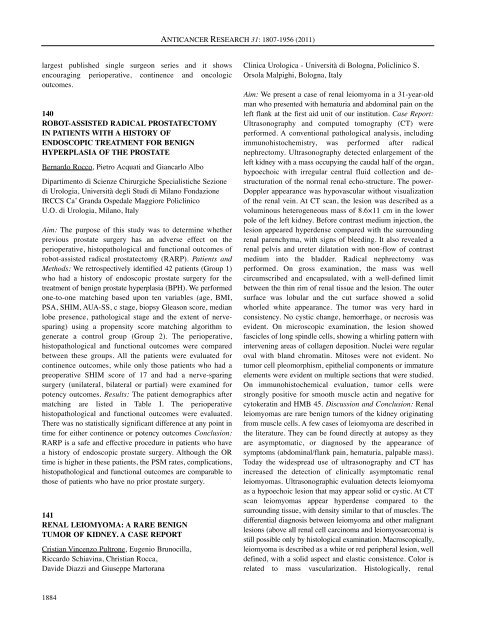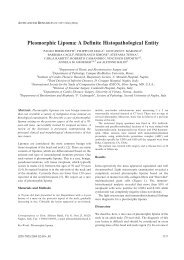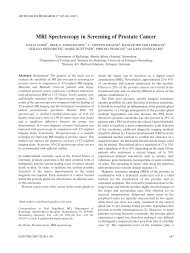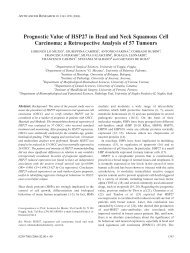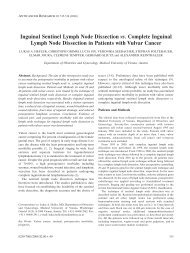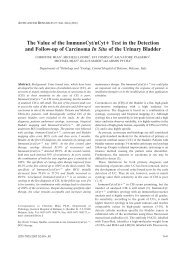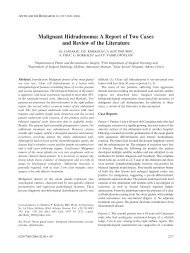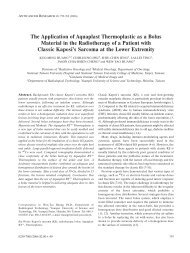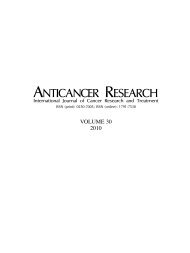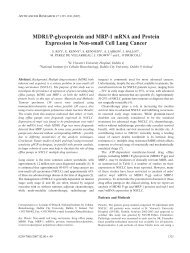ABSTRACTS OF THE 21st ANNUAL MEETING OF THE ITALIAN ...
ABSTRACTS OF THE 21st ANNUAL MEETING OF THE ITALIAN ...
ABSTRACTS OF THE 21st ANNUAL MEETING OF THE ITALIAN ...
You also want an ePaper? Increase the reach of your titles
YUMPU automatically turns print PDFs into web optimized ePapers that Google loves.
largest published single surgeon series and it shows<br />
encouraging perioperative, continence and oncologic<br />
outcomes.<br />
140<br />
ROBOT-ASSISTED RADICAL PROSTATECTOMY<br />
IN PATIENTS WITH A HISTORY <strong>OF</strong><br />
ENDOSCOPIC TREATMENT FOR BENIGN<br />
HYPERPLASIA <strong>OF</strong> <strong>THE</strong> PROSTATE<br />
Bernardo Rocco, Pietro Acquati and Giancarlo Albo<br />
Dipartimento di Scienze Chirurgiche Specialistiche Sezione<br />
di Urologia, Università degli Studi di Milano Fondazione<br />
IRCCS Ca’ Granda Ospedale Maggiore Policlinico<br />
U.O. di Urologia, Milano, Italy<br />
Aim: The purpose of this study was to determine whether<br />
previous prostate surgery has an adverse effect on the<br />
perioperative, histopathological and functional outcomes of<br />
robot-assisted radical prostatectomy (RARP). Patients and<br />
Methods: We retrospectively identified 42 patients (Group 1)<br />
who had a history of endoscopic prostate surgery for the<br />
treatment of benign prostate hyperplasia (BPH). We performed<br />
one-to-one matching based upon ten variables (age, BMI,<br />
PSA, SHIM, AUA-SS, c stage, biopsy Gleason score, median<br />
lobe presence, pathological stage and the extent of nervesparing)<br />
using a propensity score matching algorithm to<br />
generate a control group (Group 2). The perioperative,<br />
histopathological and functional outcomes were compared<br />
between these groups. All the patients were evaluated for<br />
continence outcomes, while only those patients who had a<br />
preoperative SHIM score of 17 and had a nerve-sparing<br />
surgery (unilateral, bilateral or partial) were examined for<br />
potency outcomes. Results: The patient demographics after<br />
matching are listed in Table I. The perioperative<br />
histopathological and functional outcomes were evaluated.<br />
There was no statistically significant difference at any point in<br />
time for either continence or potency outcomes Conclusion:<br />
RARP is a safe and effective procedure in patients who have<br />
a history of endoscopic prostate surgery. Although the OR<br />
time is higher in these patients, the PSM rates, complications,<br />
histopathological and functional outcomes are comparable to<br />
those of patients who have no prior prostate surgery.<br />
141<br />
RENAL LEIOMYOMA: A RARE BENIGN<br />
TUMOR <strong>OF</strong> KIDNEY. A CASE REPORT<br />
Cristian Vincenzo Pultrone, Eugenio Brunocilla,<br />
Riccardo Schiavina, Christian Rocca,<br />
Davide Diazzi and Giuseppe Martorana<br />
1884<br />
ANTICANCER RESEARCH 31: 1807-1956 (2011)<br />
Clinica Urologica - Università di Bologna, Policlinico S.<br />
Orsola Malpighi, Bologna, Italy<br />
Aim: We present a case of renal leiomyoma in a 31-year-old<br />
man who presented with hematuria and abdominal pain on the<br />
left flank at the first aid unit of our institution. Case Report:<br />
Ultrasonography and computed tomography (CT) were<br />
performed. A conventional pathological analysis, including<br />
immunohistochemistry, was performed after radical<br />
nephrectomy. Ultrasonography detected enlargement of the<br />
left kidney with a mass occupying the caudal half of the organ,<br />
hypoechoic with irregular central fluid collection and destructuration<br />
of the normal renal echo-structure. The power-<br />
Doppler appearance was hypovascular without visualization<br />
of the renal vein. At CT scan, the lesion was described as a<br />
voluminous heterogeneous mass of 8.6×11 cm in the lower<br />
pole of the left kidney. Before contrast medium injection, the<br />
lesion appeared hyperdense compared with the surrounding<br />
renal parenchyma, with signs of bleeding. It also revealed a<br />
renal pelvis and ureter dilatation with non-flow of contrast<br />
medium into the bladder. Radical nephrectomy was<br />
performed. On gross examination, the mass was well<br />
circumscribed and encapsulated, with a well-defined limit<br />
between the thin rim of renal tissue and the lesion. The outer<br />
surface was lobular and the cut surface showed a solid<br />
whorled white appearance. The tumor was very hard in<br />
consistency. No cystic change, hemorrhage, or necrosis was<br />
evident. On microscopic examination, the lesion showed<br />
fascicles of long spindle cells, showing a whirling pattern with<br />
intervening areas of collagen deposition. Nuclei were regular<br />
oval with bland chromatin. Mitoses were not evident. No<br />
tumor cell pleomorphism, epithelial components or immature<br />
elements were evident on multiple sections that were studied.<br />
On immunohistochemical evaluation, tumor cells were<br />
strongly positive for smooth muscle actin and negative for<br />
cytokeratin and HMB 45. Discussion and Conclusion: Renal<br />
leiomyomas are rare benign tumors of the kidney originating<br />
from muscle cells. A few cases of leiomyoma are described in<br />
the literature. They can be found directly at autopsy as they<br />
are asymptomatic, or diagnosed by the appearance of<br />
symptoms (abdominal/flank pain, hematuria, palpable mass).<br />
Today the widespread use of ultrasonography and CT has<br />
increased the detection of clinically asymptomatic renal<br />
leiomyomas. Ultrasonographic evaluation detects leiomyoma<br />
as a hypoechoic lesion that may appear solid or cystic. At CT<br />
scan leiomyomas appear hyperdense compared to the<br />
surrounding tissue, with density similar to that of muscles. The<br />
differential diagnosis between leiomyoma and other malignant<br />
lesions (above all renal cell carcinoma and leiomyosarcoma) is<br />
still possible only by histological examination. Macroscopically,<br />
leiomyoma is described as a white or red peripheral lesion, well<br />
defined, with a solid aspect and elastic consistence. Color is<br />
related to mass vascularization. Histologically, renal


